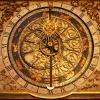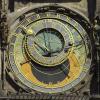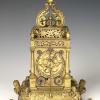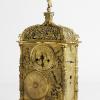Astrolabe table clock, Nuremberg, ca 1686
Commentary
Astrolabe Clock, by Johann Leonhardt Bommel, Nuremberg, ca 1686
Material: Gilt brass, steel, brass, silver. Date: (mostly) ca 1686. Location: Museum of the History of Science, Oxford, Inventory No. 35592.
Both a mechanical clock and an astrolabe, this tabletop device not only tells the time of day but also gives astronomical and calendrical information. Although it is signed with the name and location of the artist who made it (Johann Leonhardt Bommel. In Nürnberg), certain details of its making remain uncertain, and only the movement is believed to have been made while Johann was active in the late seventeenth century. The dials, side panels and figurative features – including the cherubim, lions, and basket top – are most likely nineteenth-century additions. Despite this, the elaborate device is an important indicator of how astronomical clockwork was celebrated in Renaissance Europe, during which time astrolabe-clock dials became popular (see 'related sources').
The hour dials:
Unlike our modern clock dials, which are marked from 1 to 12, the astrolabe dial on the front of the clock presents a twenty-four-hour dial, which runs from 1 to 12 (I to XII) twice in one rotation. Incorporated into the dial is a rete: a cut-out plate, most often found on astrolabes, which indicates the position of the fixed stars in the sky. Using an astrolabe, one would turn the rete by hand in one full rotation to represent the daily motion of the stars. In this model, however, the rete is rotated by the clock mechanism. When the solar arm (whose pointer is a symbol of the sun) moves clockwise, it indicates the hour of the day on the chapter ring while showing the position of the sun on the ecliptic (the circle of zodiac symbols on the rete). On the back of the clock is another twenty-four-hour dial, this time with a liturgical calendar which gives the names and dates of the saints' feasts.
For a detailed description of each of the dials, see this object's entry on the HSM's online catalogue.
For more on astrolabe-clock dials in the later Middle Ages and Renaissance, see: G. Oestmann, 'Changing the Angle of Vision: Astrolabe Dials on Astronomical Clocks,' Medieval Encounters, 23 (2017), pp. 404-20.




